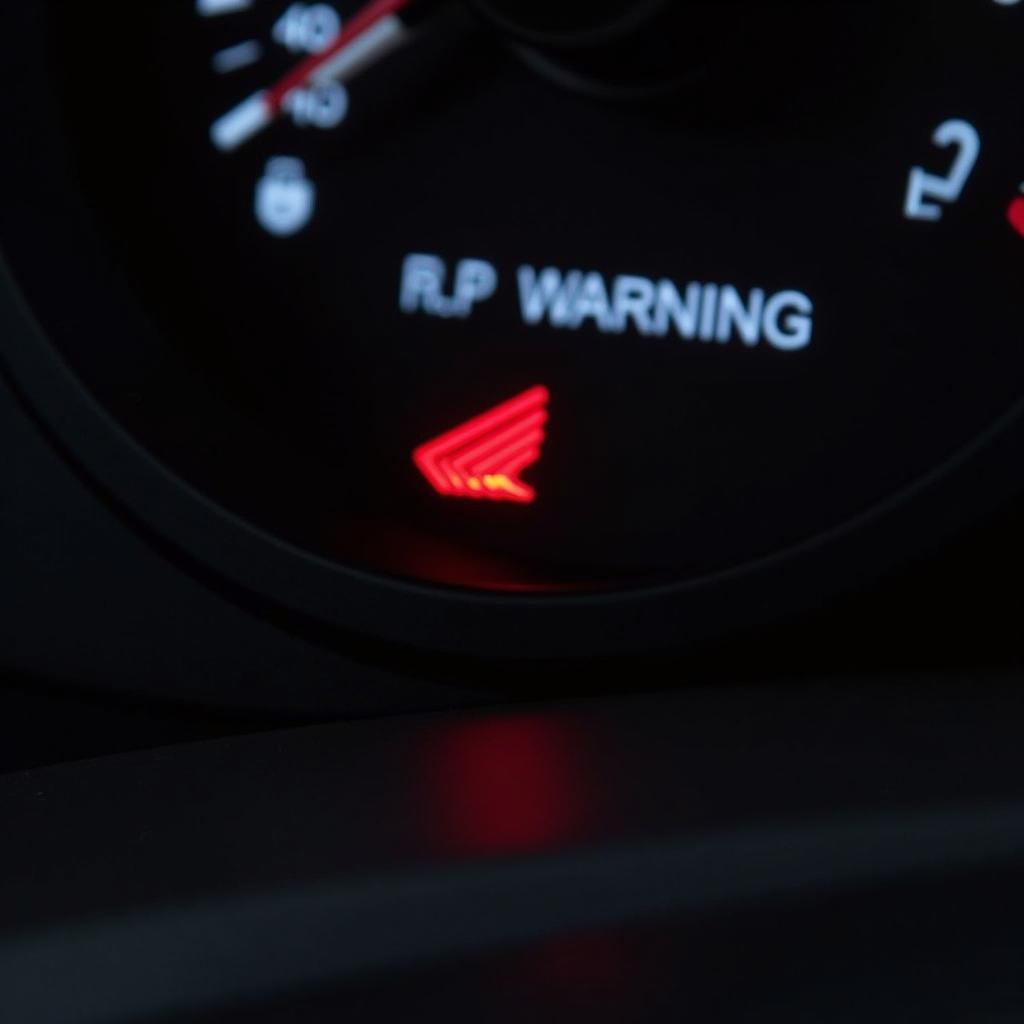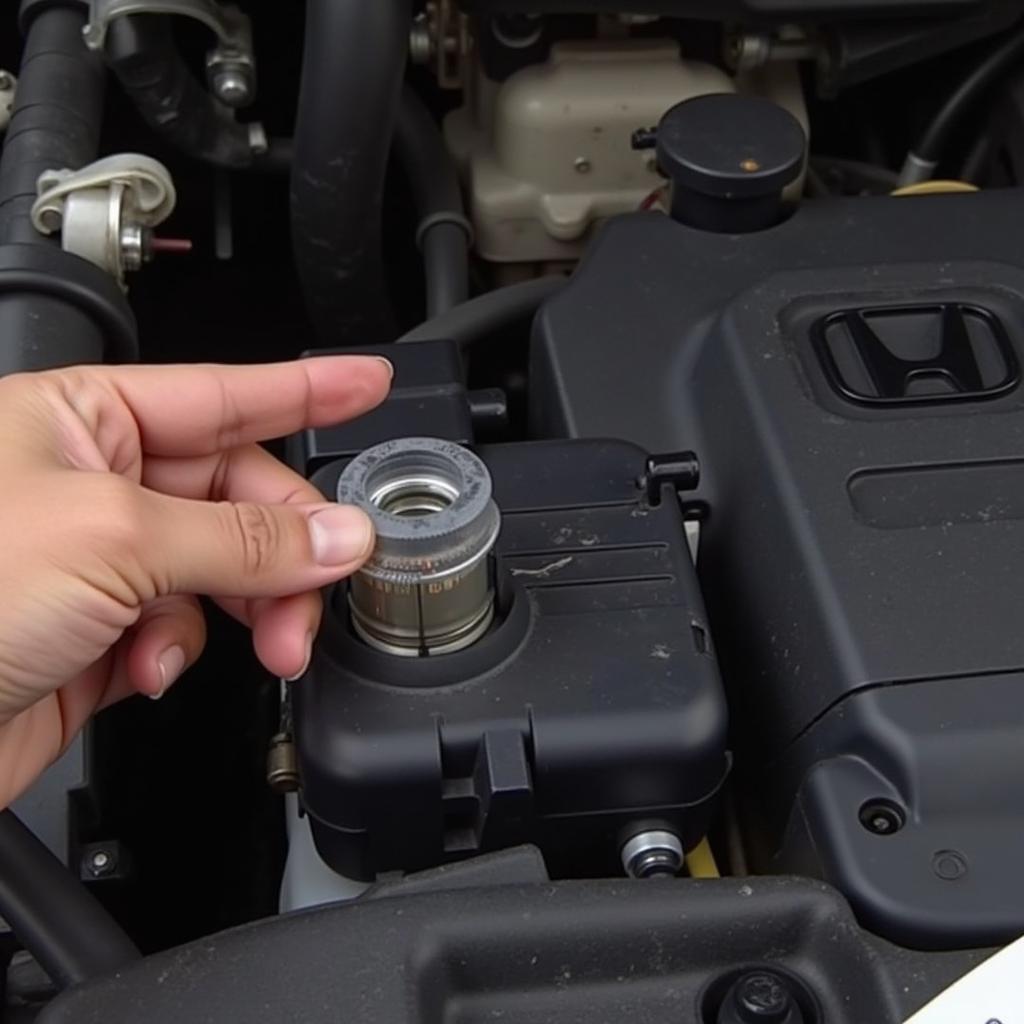The dreaded brake warning light – a sight no Honda owner wants to see illuminated on their dashboard. While it can be an unsettling experience, it’s important to understand that this warning light doesn’t necessarily signify a catastrophic failure. Instead, it serves as your car’s way of communicating a potential issue with your braking system that needs attention. This article will guide you through the common causes of a brake warning light in Honda vehicles and provide you with insights on how to address them.
Understanding Your Honda’s Brake Warning Light
 Honda Dashboard Brake Warning Light
Honda Dashboard Brake Warning Light
In most Honda models, the brake warning light is a single symbol that illuminates in red or orange on your dashboard. This light can indicate several issues, ranging from a simple reminder to engage the parking brake to more critical problems like low brake fluid levels or a malfunction within the braking system.
Common Reasons Your Honda Brake Warning Light is On
Several factors can trigger the brake warning light in your Honda. Here’s a breakdown of the most common culprits:
1. Engaged Parking Brake
This is the most straightforward and often the least alarming reason. If you start your car or begin driving with the parking brake even partially engaged, the brake warning light will illuminate. Simply disengaging the parking brake should make the light turn off.
2. Low Brake Fluid Level
 Checking Brake Fluid Level in Honda
Checking Brake Fluid Level in Honda
Brake fluid is the lifeblood of your car’s braking system. It’s a hydraulic fluid that transmits the force from your foot on the brake pedal to the brake calipers, effectively stopping your vehicle. A leak in the braking system or worn-out brake pads can cause the brake fluid level to drop. If the fluid level gets too low, the brake warning light will activate.
3. Worn Brake Pads
Your Honda’s braking system is equipped with wear indicators on the brake pads. As the brake pads wear down over time, these indicators will come into contact with the brake rotor, triggering the brake warning light.
4. Faulty Brake Light Switch
The brake light switch is a small component responsible for activating your brake lights when you press the brake pedal. If this switch malfunctions, it can also trigger the brake warning light on your dashboard, even if there’s no actual issue with the braking system.
5. ABS System Malfunction
Modern Honda vehicles are equipped with an Anti-lock Braking System (ABS). The ABS system plays a crucial role in preventing wheel lockup during hard braking, thereby maintaining steering control. If the ABS system encounters a problem, a separate warning light might illuminate on the dashboard, sometimes accompanied by the brake warning light.
Troubleshooting a Brake Warning Light in Your Honda
Here are some steps you can take to troubleshoot a brake warning light:
-
Check Your Parking Brake: Ensure your parking brake is fully disengaged.
-
Inspect Brake Fluid Level: If you’re comfortable under the hood, check the brake fluid level in the reservoir. Refer to your owner’s manual for the location and instructions. If the fluid level is low, it’s best to have the system inspected for leaks by a professional technician.
-
Visual Inspection of Brake Pads: While not always easily accessible, try to visually inspect your brake pads if possible. Look for significant wear or if they appear thin.
-
Avoid Driving: If the brake warning light remains illuminated, or if you notice any unusual behavior with your brakes like a spongy brake pedal or unusual noises, it’s crucial to stop driving immediately and have your vehicle towed to a trusted mechanic or dealership for a thorough inspection.
When to Seek Professional Help
While some causes of a brake warning light can be easily addressed, others require professional attention. If you are unsure about any aspect of your car’s braking system or suspect a more severe issue, do not hesitate to contact a qualified mechanic.
Remember, your car’s braking system is critical for your safety and the safety of others on the road. Never ignore a brake warning light, and address any potential problems promptly.
FAQs About Honda Brake Warning Lights
Q1: Can I drive my Honda with the brake warning light on?
A: It’s highly discouraged to drive with the brake warning light on. Doing so could potentially worsen the issue and put your safety at risk.
Q2: How often should I get my Honda’s brakes checked?
A: It’s generally recommended to have your brakes inspected every 12,000 miles or as part of your regular maintenance schedule.
Q3: How much does it cost to fix a brake warning light issue in a Honda?
A: The cost varies depending on the underlying cause. It could range from a simple brake fluid top-up to a more complex repair like replacing brake calipers or the ABS module.
Q4: My Honda CRV brake warning light is on. What could be the specific reasons?
A: The common reasons for a brake warning light apply to most Hondas, including the CRV. However, you can find more specific information about the brake system in your CRV owner’s manual. You can also read more about the Honda CRV brake warning light here: brake warning light honda crv.
Q5: The brake system warning light is on in my Honda Civic. What does it mean?
A: A brake system warning light in a Honda Civic often indicates similar issues as a general brake warning light. For a deeper understanding of the brake system warning light specific to the Civic model, refer to this comprehensive guide: brake warning light honda civic.
Remember, addressing any potential brake system issues promptly will help ensure a safe and enjoyable driving experience in your Honda.


